It looks like you're using an Ad Blocker.
Please white-list or disable AboveTopSecret.com in your ad-blocking tool.
Thank you.
Some features of ATS will be disabled while you continue to use an ad-blocker.
share:
a reply to: Gully
im sure gravity is taking its piece somewhere in their motion, but as illustrated above why do we see two directions of travel between the two . illustrated, the alteration and shape change with the larger of the two is disconcerting to say the least
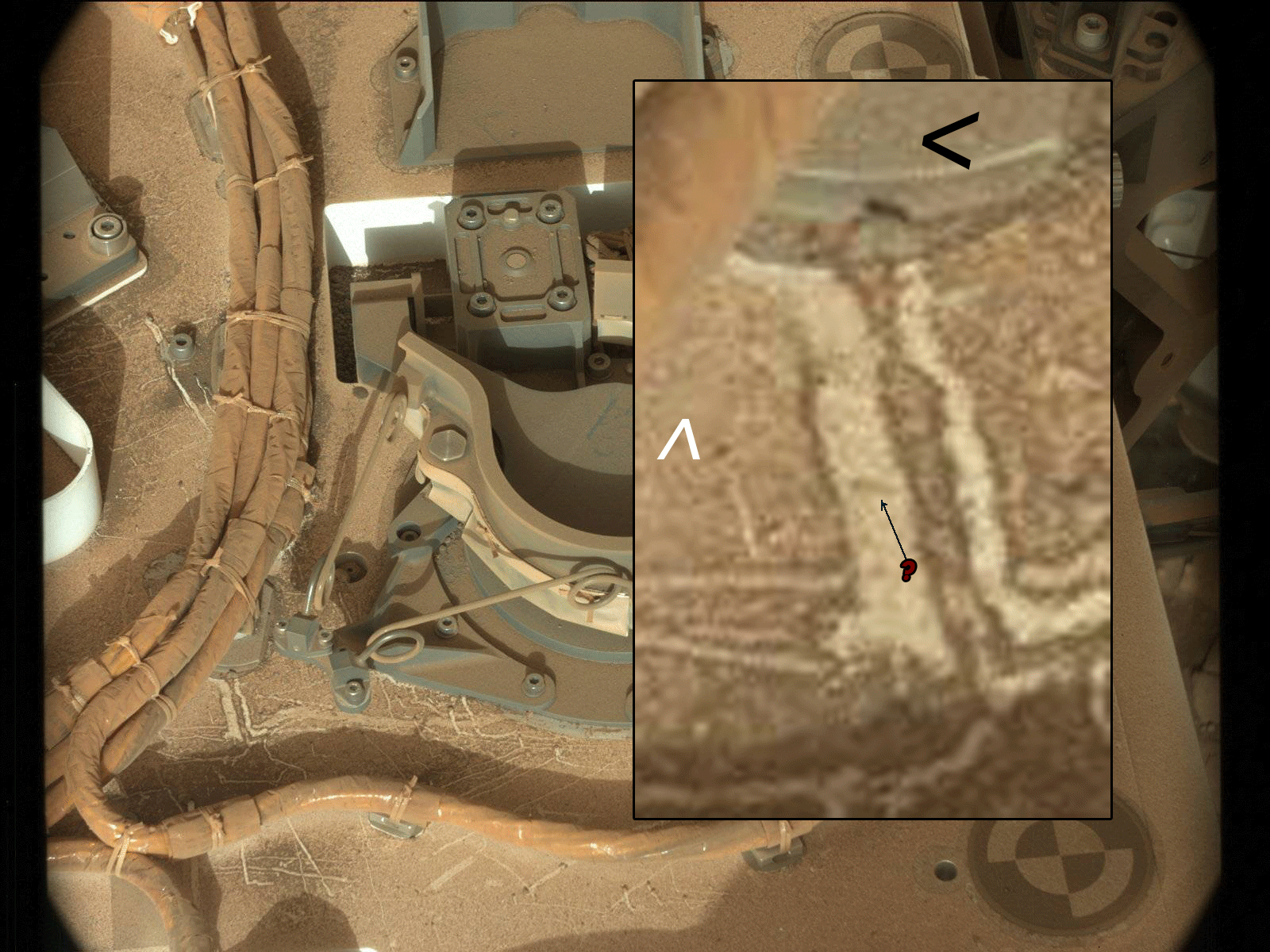
funbox
im sure gravity is taking its piece somewhere in their motion, but as illustrated above why do we see two directions of travel between the two . illustrated, the alteration and shape change with the larger of the two is disconcerting to say the least

funbox
edit on 7-10-2014 by funbox because: wolves ! wrong pic
a reply to: funbox
This one has had me fascinated since I saw it on the anomalies thread.
The small globs at the end of the trails don't look to behave like a liquid.
They must be sticky as they do a good job getting through some of that thick dust.
And the way the trails start is interesting.
Can someone point out the location of this on the rover?
Cheers guys
This one has had me fascinated since I saw it on the anomalies thread.
The small globs at the end of the trails don't look to behave like a liquid.
They must be sticky as they do a good job getting through some of that thick dust.
And the way the trails start is interesting.
Can someone point out the location of this on the rover?
Cheers guys
originally posted by: funbox
im sure gravity is taking its piece somewhere in their motion, but as illustrated above why do we see two directions of travel between the two
I think maybe the top one has run up against a piece of metal and is continuing "downward" along the side.
But here's a question. Taking how far the lumps travel in a seven-minute period between the images, is it possible to calculate just how long they have persisted by measuring back along the length of the trail? They don't move very much. Assuming they move at a more or less constant speed, it must take them a relatively long time to make a trail that long. Hours, even. That seems to me like a long time for water to hang out in the open atmosphere of Mars.
edit on 7-10-2014 by Blue Shift because: (no reason given)
I suspect that when the rover moves, the vibration of the ultra fine dust particles facilitates any larger particles to slide around leaving the
streaks.
originally posted by: TinfoilTP
I suspect that when the rover moves, the vibration of the ultra fine dust particles facilitates any larger particles to slide around leaving the streaks.
I'm not sure the rover is moving between the images. It's been lingering in the same spot for several Sols. It has been working the drill, though. That would cause vibrations.
originally posted by: TinfoilTP
I suspect that when the rover moves, the vibration of the ultra fine dust particles facilitates any larger particles to slide around leaving the streaks.
Sorta like cornmeal on a pizza peel to make it easy to slide off a pizza into the oven? I could see that.
a reply to: Blue Shift
its like in this picture , where the trail adheres to the nut housing and then veers off it , only viscosity would be so clingy
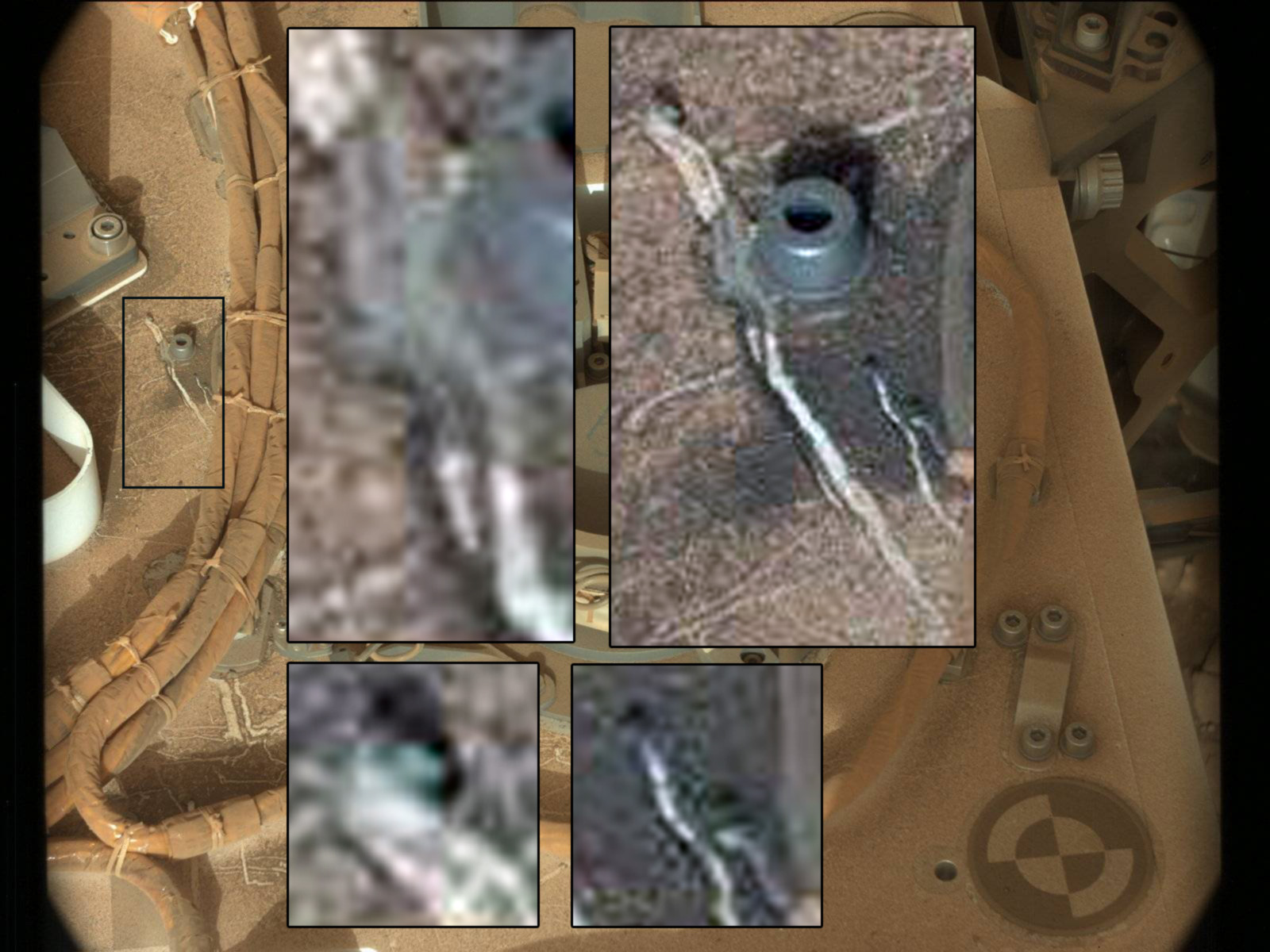
funbox
its like in this picture , where the trail adheres to the nut housing and then veers off it , only viscosity would be so clingy

funbox
Look at the darker edges of the streaks, is that gathered up dust that's been pushed outwards, or is it damp dust?
a reply to: Shaded27
it appears to look that way, but then what would be the outward force ? , would water have such building power, and why wouldn't it be absorbed by the surrounding dust, surely it would lose momentum as it makes it's way into dryer areas of dust
funbox
it appears to look that way, but then what would be the outward force ? , would water have such building power, and why wouldn't it be absorbed by the surrounding dust, surely it would lose momentum as it makes it's way into dryer areas of dust
funbox
originally posted by: Blue Shift
originally posted by: funbox
im sure gravity is taking its piece somewhere in their motion, but as illustrated above why do we see two directions of travel between the two
I think maybe the top one has run up against a piece of metal and is continuing "downward" along the side.
But here's a question. Taking how far the lumps travel in a seven-minute period between the images, is it possible to calculate just how long they have persisted by measuring back along the length of the trail? They don't move very much. Assuming they move at a more or less constant speed, it must take them a relatively long time to make a trail that long. Hours, even. That seems to me like a long time for water to hang out in the open atmosphere of Mars.
that's the question
some of them trails are long , and look like thier movement is edging .. hours to make .. surely not ??
ahh the time stamps. may as well post them up
Mastcam: Left
2014-10-01 06:12:34 UTC
Mastcam: Left
2014-10-01 06:03:46 UTC
sol 765 mast
funbox
originally posted by: Shaded27
Can someone point out the location of this on the rover?
I think it's the area marked in blue in the following image.
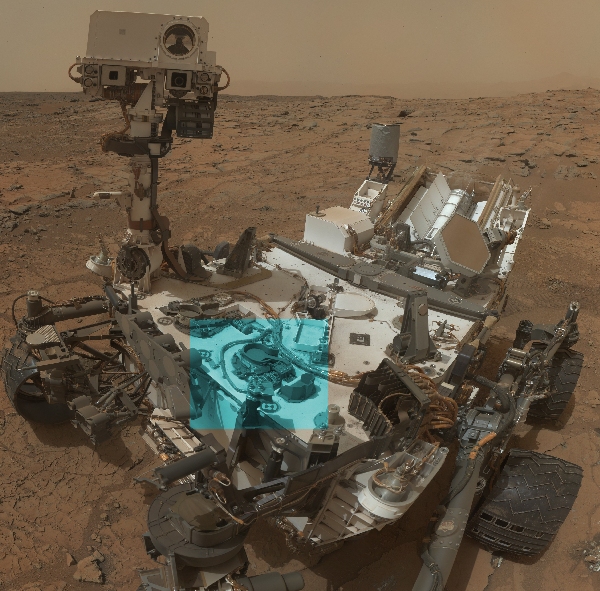
Edit: the image above is a smaller, cropped and marked version of this image.
edit on 7/10/2014 by ArMaP because: (no reason given)
a reply to: ArMaP
seems like a fairly central and flat area, do you know if this area tilts or has any extremes of position from what we see here
and
did you spot the other trails in your pic ?
stange how it appears that one is moving up the same trail, I guess threse no other pictures to make a timelapse ?
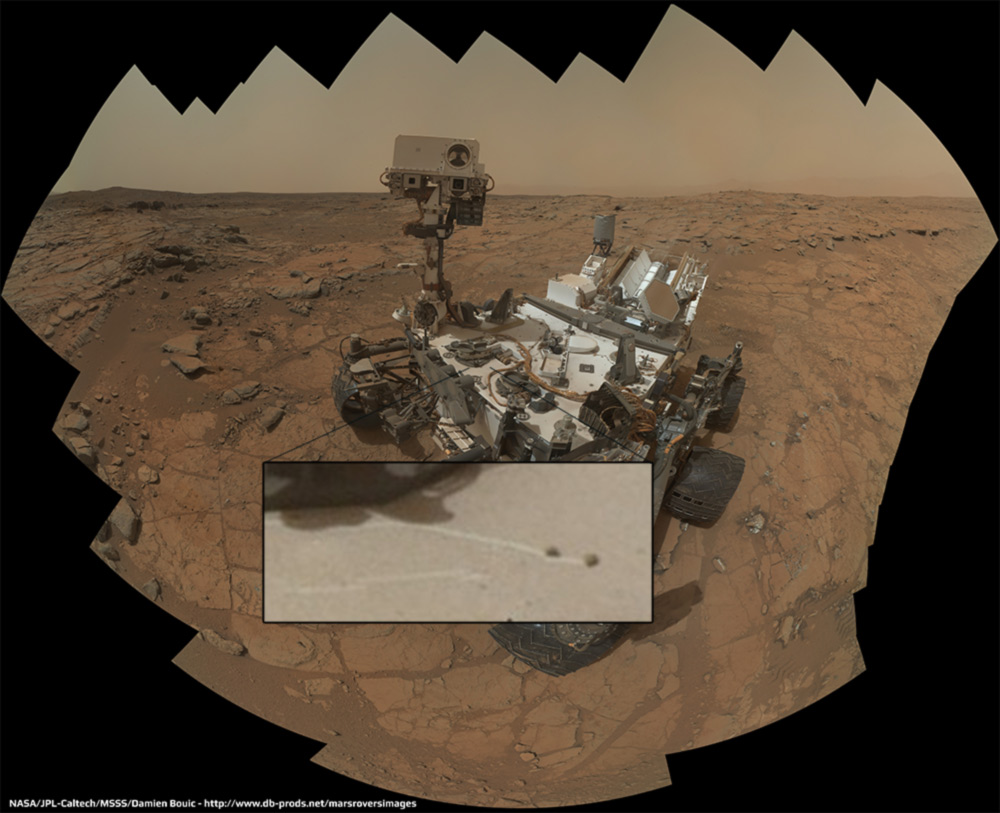
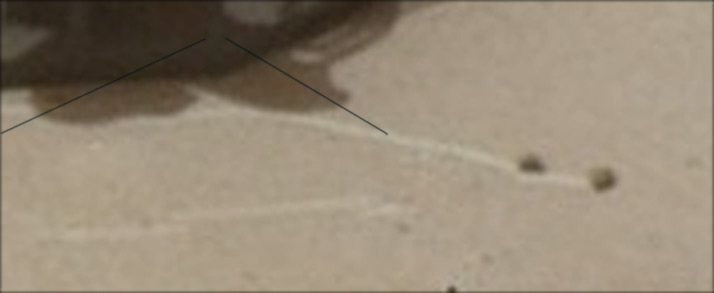
funbox
seems like a fairly central and flat area, do you know if this area tilts or has any extremes of position from what we see here
and
did you spot the other trails in your pic ?
stange how it appears that one is moving up the same trail, I guess threse no other pictures to make a timelapse ?


funbox
edit on 7-10-2014 by funbox because: extra pic
a reply to: funbox
Another good find, and since these things haven't been noticed before then you guys have the inside track on the claim, no matter what youtube airhead steals this without giving credit. The next step is to go back on older pics of Curiosity to see if these tracks and whatchamacallits have been showing up the entire time that the rover has roved, or to pin down if this is a recent phenomena.
Another good find, and since these things haven't been noticed before then you guys have the inside track on the claim, no matter what youtube airhead steals this without giving credit. The next step is to go back on older pics of Curiosity to see if these tracks and whatchamacallits have been showing up the entire time that the rover has roved, or to pin down if this is a recent phenomena.
originally posted by: Aleister
The next step is to go back on older pics of Curiosity to see if these tracks and whatchamacallits have been showing up the entire time that the rover has roved, or to pin down if this is a recent phenomena.
That rover image is a mosaic from sol 177, so it can be considered an old image.
originally posted by: ArMaP
originally posted by: Aleister
The next step is to go back on older pics of Curiosity to see if these tracks and whatchamacallits have been showing up the entire time that the rover has roved, or to pin down if this is a recent phenomena.
That rover image is a mosaic from sol 177, so it can be considered an old image.
Fascinating, as Mr. Spock would say. Thanks.
a reply to: smurfy
There can be no dew on Mars. The air pressure is to low to allow liquid water to condense. Frost is possible in the Martian winter, but no dew. And no possibility of liquid water (unless it's very, very salty) except for a few regions (of which Gale Crater is not one).
there is a dew on Mars, perhaps because of the dust, the dew found it's own natural path downward, the lines are now the beaten track of the water, the dust builds up each side of the channel, the channels become more pronounced.
Can you provide a bit more context?
Richard Hoover spoke about liquid water on Mars too, in fact his words were, "I know there is liquid water on Mars".
As Phage alluded to above, the other case of purported persistent liquid water on Mars had been water that was perhaps very salty. That purported
water was observed on the leg strut of the Phoenix Lander back in 2008. The Phoenix Lander was located in Mars' north arctic region.
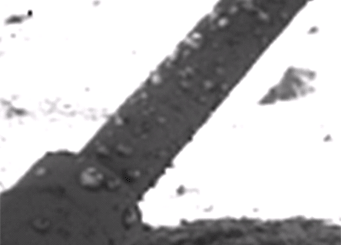 Image caption from below article: Droplets on a leg of the Phoenix lander enlarge and coalesce in this
image sequence taken on sols (Martian days) 8, 31, and 44 following the craft's arrival in the north polar region of Mars [in 2008]
Image caption from below article: Droplets on a leg of the Phoenix lander enlarge and coalesce in this
image sequence taken on sols (Martian days) 8, 31, and 44 following the craft's arrival in the north polar region of Mars [in 2008]
(Drops of) Water on Mars?
More information:
Underneath Phoenix Lander 97 Sols After Touchdown

(Drops of) Water on Mars?
Liquid water would hardly be expected at the north-polar landing site, where the temperature never climbed above -5°F (-20°C) during five months of operation. For example, images showed that whenever the lander's mechanical scoop unearthed fresh exposures of ice, it quickly sublimated (vaporized) directly into the atmosphere.
The key to keeping water from freezing, Renno explained, was the discovery that the silty, clumpy soil in the landing zone contains abundant chlorine-rich salts called perchlorates. Through a process called deliquescence, the salty spatter on the landing strut absorbed enough water vapor directly from the thin Martian air to liquefy. These droplets of concentrated brine freeze at temperatures some 125°F (70°C) lower than that for water alone.
More information:
Underneath Phoenix Lander 97 Sols After Touchdown
edit on 10/8/2014 by Soylent Green Is People because: (no reason given)
a reply to: Soylent Green Is People
interesting stuff on the phoenix lander , as ArMaP pointed out ,but is this really comparable to the picture were seeing from curiosity.. 7 minuets is quite a short time for seeing the movement we are seeing
these nodules took months and months to develop, interesting ,but I don't think its what were seeing here , given the variables like latitude (warmer environ) time period, evidence of movement etc
funbox
interesting stuff on the phoenix lander , as ArMaP pointed out ,but is this really comparable to the picture were seeing from curiosity.. 7 minuets is quite a short time for seeing the movement we are seeing
these nodules took months and months to develop, interesting ,but I don't think its what were seeing here , given the variables like latitude (warmer environ) time period, evidence of movement etc
funbox
a reply to: funbox
Interesting, though I believe mars to now be a dead world I am on the so called fringe in that I believe there are ancient structures on the surface though weather they are that ancient or relatively speaking younger than the devastation and climate change that killed mars is another debate.
This could be fluid, maybe not water as at the pole's CO2 freezes solid and may also enter that intermediate stage of fluid before evaporating, it is possible that as the rover has disturbed the area knocking shading material away that some CO2 has been exposed to sunlight and melted passing through that state and in some areas nearer the polar regions it may be possible that CO2 can be found in pool's not just of ice but liquid, of course mars also had and may still have vast amount's of water but since it's atmosphere is now too thin, not helped by the fact it actually condenses at the poles, water in a fluid form is highly unlikely (not impossible though) though it may exist near volcanic regions were the mantle still provides enough warmth though it is unlikely at the surface except perhaps as a result of subsurface geothermal releases, there may be vast submartian aquafers that perhaps hold trillion's of litres of water deep beneath the surface as well as ice layers buried beneath the old sea bed's that any future colonization could take advantage of to produce fuel and oxygen.
Of course just like life has been found up to 4000 feet beneath the surface of the earth it may also mean that microbial life may still exist at these depth's or even deeper on mars kept warm by ancient geotherman heat and still liquid water to disolve nutrient's from the rock.
Interesting, though I believe mars to now be a dead world I am on the so called fringe in that I believe there are ancient structures on the surface though weather they are that ancient or relatively speaking younger than the devastation and climate change that killed mars is another debate.
This could be fluid, maybe not water as at the pole's CO2 freezes solid and may also enter that intermediate stage of fluid before evaporating, it is possible that as the rover has disturbed the area knocking shading material away that some CO2 has been exposed to sunlight and melted passing through that state and in some areas nearer the polar regions it may be possible that CO2 can be found in pool's not just of ice but liquid, of course mars also had and may still have vast amount's of water but since it's atmosphere is now too thin, not helped by the fact it actually condenses at the poles, water in a fluid form is highly unlikely (not impossible though) though it may exist near volcanic regions were the mantle still provides enough warmth though it is unlikely at the surface except perhaps as a result of subsurface geothermal releases, there may be vast submartian aquafers that perhaps hold trillion's of litres of water deep beneath the surface as well as ice layers buried beneath the old sea bed's that any future colonization could take advantage of to produce fuel and oxygen.
Of course just like life has been found up to 4000 feet beneath the surface of the earth it may also mean that microbial life may still exist at these depth's or even deeper on mars kept warm by ancient geotherman heat and still liquid water to disolve nutrient's from the rock.
edit on 8-10-2014 by LABTECH767 because: (no reason given)
new topics
-
Paramilitary Leaks - John Williams
Whistle Blowers and Leaked Documents: 1 minutes ago -
Some sausage, some chicken, some sauce, some onions and some garlic...and some peppers!
Food and Cooking: 1 hours ago -
Hearing more ambulances lately
Medical Issues & Conspiracies: 1 hours ago -
Los Angeles brush fires latest: 2 blazes threaten structures, prompt evacuations
Mainstream News: 1 hours ago -
House Passes Laken Riley Act
Mainstream News: 2 hours ago -
The more I think about it
General Chit Chat: 3 hours ago -
What Comes After January 20th
Mainstream News: 5 hours ago -
Canada as a state .. how would it work?
General Chit Chat: 5 hours ago -
Those stupid GRAVITE commercials
Rant: 5 hours ago -
Let's Buy Greenland
General Chit Chat: 6 hours ago
top topics
-
What Comes After January 20th
Mainstream News: 5 hours ago, 16 flags -
House Passes Laken Riley Act
Mainstream News: 2 hours ago, 15 flags -
Claim: General Mark Milley Approved Heat and Sound Directed Energy Weapons During 2020 Riots
Whistle Blowers and Leaked Documents: 11 hours ago, 12 flags -
Planned Civil War In Britain May Be Triggered Soon
Social Issues and Civil Unrest: 9 hours ago, 6 flags -
Let's Buy Greenland
General Chit Chat: 6 hours ago, 5 flags -
Those stupid GRAVITE commercials
Rant: 5 hours ago, 5 flags -
Hearing more ambulances lately
Medical Issues & Conspiracies: 1 hours ago, 4 flags -
Some sausage, some chicken, some sauce, some onions and some garlic...and some peppers!
Food and Cooking: 1 hours ago, 3 flags -
Los Angeles brush fires latest: 2 blazes threaten structures, prompt evacuations
Mainstream News: 1 hours ago, 3 flags -
The more I think about it
General Chit Chat: 3 hours ago, 3 flags
active topics
-
This is why ALL illegals who live in the US must go
Social Issues and Civil Unrest • 37 • : WatchingWatchers -
Paramilitary Leaks - John Williams
Whistle Blowers and Leaked Documents • 0 • : FullHeathen -
House Passes Laken Riley Act
Mainstream News • 8 • : VariedcodeSole -
Get Ready - Here comes the Bird Flu Pandemic - Millions are Notified
Diseases and Pandemics • 69 • : 38181 -
Hearing more ambulances lately
Medical Issues & Conspiracies • 2 • : JJproductions -
Planned Civil War In Britain May Be Triggered Soon
Social Issues and Civil Unrest • 12 • : UpIsNowDown2 -
Let's Buy Greenland
General Chit Chat • 14 • : xuenchen -
Los Angeles brush fires latest: 2 blazes threaten structures, prompt evacuations
Mainstream News • 5 • : xuenchen -
ILLUMINATION: Dimensions / Degrees – Da Vincis Last Supper And The Philosophers Stone
Secret Societies • 17 • : Compendium -
Some sausage, some chicken, some sauce, some onions and some garlic...and some peppers!
Food and Cooking • 2 • : DAVID64
